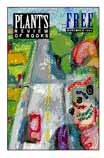

How do you say "politically correct" in German? You could probably ask Constance Wechselburger, the protagonist of With the Next Man Everything Will Be Different, a first novel by German cartoonist and writer Eva Heller. Constance wants terribly badly to avoid falling into the money-centered, bourgeois lifestyle she sees waiting for her after grad school. Unfortunately, it's a little hard to épater le bourgeoisie properly when Daddy's paying most of the bills, your doctor boyfriend is footing the rest of the tab and expecting you to make like a hausfrau in return, and your friends all seem to be buying into one pre-designed lifestyle package or another.
What Constance wants is romance--but not the same old sexist schlock. She's looking for a courtly knight who'll ride up in a funky old blue Mercedes with all the right political bumperstickers, give her plenty of personal space but share everything with her, and be sensitive yet strong. So out goes her young doctor, Albert, a tight-assed, button-down authoritarian who whinges over wasted toothpaste. In comes the search for Fantasy Man, hopefully embodied by her favorite film professor, Gottfried Schachtschnabel.
That her idol has feet (and possibly also legs, gonads and brain) of clay is evident to the reader right away. But it's fun to see him through Constance's eyes, as he puts a spell on an impressionable young woman who sees in him only what she wants to see. We, on the other hand, are standing far enough outside to see just how boring, self-indulgent and full of baloney his lectures on "The Relevance of Bourgeois Romanticism to the Hollywood Ideal" really are.
Hardly the type to spend all her time obsessing about a man, Constance also seeks out new friendships with women--the better to talk about men, of course. Juliet, a recently-divorced psychiatrist, catches her ear at the neighborhood singles bar. Old friends Sieglinde and Wolf-Dietrich play the part of Young Yuppies in Love, parading their latest acquisitions at parties arranged more to assist them in their social climbing than anything else. The always-knitting crew of students in her women's film seminar talk big about smashing patriarchy, and end up single parents when those sensitive types take a powder at the first sign of pregnancy.
In taking a humorous look at the twentysomethings of Berlin, Heller picks her targets well. In her search for an alternative to the traditional marriage she's fleeing, Constance explores all the options. Could communal life be a substitute? Maybe not, she discovers at her ex-boyfriend's old commune. "All day long they had these discussions," she writes. "What is dirt? Where does it come from? Where does dirt go? Who's responsible for it? The third time I visited the commune, Dagmar put me on the list for cleaning--because I'd stood around on the kitchen floor--their common space!"
Ditto for "romantic love" of the sort she sometimes daydreams about. She answers a personal ad from a man who sounds like the kindred spirit she's been seeking ("Your free spirit despises norms and is open to the deeper meaning of existence. You like politics...you are intellectual to the depths of your soul," ad nauseum). Mr. Right turns out to be...a Ms., accidentally placed in the "Men Seeking Women" column. Even Constance's vapid, television-obsessed friend Birgit can't find her Prince Charming in an advertisement, and she meets all the usual "25 or under, shapely and stunning" credentials. Also tossed by the wayside: obnoxious barfly pickups, PC wormboys and uptight old flames.
Constance hopes an artistic film that uses her breakup with Albert as a political and sociological symbol will be her key to self-understanding and, not incidentally, to Schachtschnabel's heart. The titles she comes up with - "Class Struggle and Love," "My Love for You Is Like the Dying Forest" (a love story with ecological overtones, of course), "The Woman With Cemented Pinions"--are howlers. The hilarity only increases as she expands on her theme for the prof: "Albert, in an American gas-guzzler, races through the Black Forest at 120 mph. We see the needles raining off the trees. Albert rolls down the window and, with an aggressive leer on his face, tosses a cigarette butt into the forest..." This reviewer senses the revenge of a former film student in Heller's spot-on parodies of what passes for "serious cinema" at universities here and abroad.
But before Constance can even finish the script, her own life takes more twists and turns than a bad film plot. Some, such as a temp job at an advertising agency that turns into a consciousness-raising experience, are not as well integrated into the storyline as they could be. Other side trips, including a visit to Constance's parents, who expect to see a wedding ring in exchange for all the expensive education they've been paying for, add depth and motivation to Heller's characters.
The ending is a bit pat, but this story is played for laughs as well as for serious parody. Even in translation, where some of the flavor of words is always lost, Heller has a gift for sketching complex personalities in a few paragraphs. Even genuinely unsympathetic characters like the whining, materialistic Sieglinde aren't drawn as stereotypes. While satire is so often cruel, Heller's portraits of Constance and her compatriots are instead the kind of gentle parodies that let readers recognize themselves in the literary mirror without receiving a hard slap in return.
The influence of American brat-pack writers like Bret Easton Ellis is evident in some of the tale's pop-culture underpinnings and brand-name dropping, but there's none of the self-absorbed, pity-the-poor-rich-kid bawling, or phony shock therapy readers have come to expect from his ilk. That, along with some passages of truly witty writing, make this a postmodern "love" story that you can read without running for the Alka-Seltzer even once.




 Return to Facing
Return to Facing